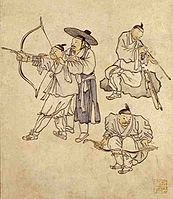Wangjin
| Wangjin/Manggeon | |||
|---|---|---|---|
 Wangjin | |||
| Chinese name | |||
| Simplified Chinese | 网巾 | ||
| |||
| Korean name | |||
| Hangul | 망건 | ||
| Hanja | 網巾 | ||
| |||
Wangjin is a kind of traditional headband worn by adult men in the Chinese Ming Dynasty. A similar head band to the Chinese wangjin is the Korean manggeon of the Joseon period. It is used to hold their hair in place after the topknot is done. The wangjin is usually made of made of fibers, and Koreans contributed to the manggeon's evolution with new material, dyed and woven horsehair. This headband, similar to the wangjin, was also worn during the Vietnamese Later Lê dynasty to the Nguyễn dynasty and in the Ryukyu Kingdom.
History[]
According to the legend, the earliest people who wore wangjin were Taoist priests. One day, the Hongwu Emperor of Ming Dynasty wore common clothes to visit the folk and he saw a Taoist priest wearing wangjin on top of his head. The emperor asked what it was, to which the priest answered, "This is wangjin. Wear it on top of your head, then your hair will gather together" (ref. "此曰網巾. 裹以頭, 則萬髮俱齊"). The emperor was very satisfied with the answer that also referred to uniting the country. After the emperor returned to his palace, he ordered all the men in the country, from the emperor to the common man, to wear wangjin. Since then, wangjin has become the common headgear of adult men in the entire country.
After the collapse of the Ming Dynasty, the Manchu people established the Qing Dynasty, and due to the Manchu government policy banning Chinese people from wearing Hanfu and forcing them to shave their hair and wear a queue, the use of wangjin in China came to an end.
Influences and derivatives[]
The Korean manggeon was originally brought from China but over time developed distinct features. The Korean manggeon is made from horsetail hair – an innovation that was introduced back to China.[citation needed] Also, the manggeon only covered the forehead when worn.
Gallery[]

Modern replica of a wangjin.

Male working on winnowing machine, illustrated in the book Tiangong Kaiwu from the Ming dynasty.

Joseon men wore wangjin (manggeon) on the head.
See also[]
- Chinese headgear
- Korean headgear


